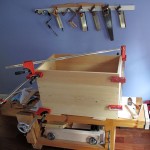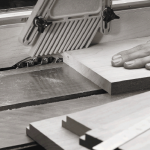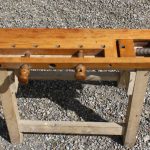We may receive a commission when you use our affiliate links. However, this does not impact our recommendations.
If you’ve been reading Popular Woodworking Magazine for more than a decade, two “new” products won’t be new to you: “Workbenches & Toolboxes” and “Great American Furniture.” Both are “SIPs” (special-interest publications) that we offered only on newsstands, before I joined the PWM staff (so they’re really old). But they’re chock-full of great information, and while much of our legacy content (a fancy industry term for existing material) has long been available as digital downloads at ShopWoodworking.com, these two took a bit of work to make them download-ready.
 In “Great American Furniture,” you’ll find 11 classic projects. Representing Shaker: a Candle Stand by Malcolm Huey, Glen Huey’s Press Cupboard (his most popular project ever) and a hand-tool Stepstool by Jim Stuard. Designs from the 18th-century include: simple sliding-lid Candle Boxes by Troy Sexton, a Butler’s Tray Table by Jim Stuard and Glen Huey’s Pennsylvania Spice Box. The Arts & Crafts period is represented by: a Greene & Greene side table by Steve Shanesy and David Thiel’s Morris Chair. In the contemporary corner we have: Christopher Schwarz’s Nicolai Fechin-style Bench (a project I’ve never seen before!) and his Rice-paper Maple Lamp and, finally, Plywood Nesting Tables by David Thiel.
In “Great American Furniture,” you’ll find 11 classic projects. Representing Shaker: a Candle Stand by Malcolm Huey, Glen Huey’s Press Cupboard (his most popular project ever) and a hand-tool Stepstool by Jim Stuard. Designs from the 18th-century include: simple sliding-lid Candle Boxes by Troy Sexton, a Butler’s Tray Table by Jim Stuard and Glen Huey’s Pennsylvania Spice Box. The Arts & Crafts period is represented by: a Greene & Greene side table by Steve Shanesy and David Thiel’s Morris Chair. In the contemporary corner we have: Christopher Schwarz’s Nicolai Fechin-style Bench (a project I’ve never seen before!) and his Rice-paper Maple Lamp and, finally, Plywood Nesting Tables by David Thiel.
“Workbenches & Toolboxes” includes 10 shop projects: Christopher Schwarz’s Power-tool Workbench (it was “my” bench when I joined the staff, and now belongs to Chris’s father), $230 Workbench, Sliding Deadman bench accessory, Arts & Crafts Tool Cabinet and his Stanley Tool Cabinet, an I-Beam Work Island by Nick Engler, the Bullet-proof Workbench by Jim Stuard, David Thiel’s Height-adjustable Modular Bench (I don’t know what’s happened to the top of that project, but the bases are still kicking around), a Machinist’s Tool Chest by Jim Stack and a German Work Box by David Thiel and Michael Rabkin . (And, um, somehow the Table of Contents ended up in the middle of the PDF – but all the pages for article story are together – promise. Get your “special” copy now…before I upload a new file! )

Yup. That’s Chris from long ago. Gluing up the top for one of his first of…I don’t know…493? workbenches.
So why did it take us so long to make these available in the digital age? If you care, read on. If you (and you know who you are) are going to complain that the following isn’t about woodworking, please stop reading and go cut a mortise or dovetail (both of which are on my agenda for the week).
As do many publications, we now use the Adobe Creative Suite to produce Popular Woodworking Magazine, as well as the woodworking books (and every other publication our parent company, F+W Media, publishes). It’s a fairly seamless operation. Photographs are processed in PhotoShop. Illustrations are (usually) created in SketchUp as 3D models, then output for print using Illustrator (and added to our 3D warehouse as free project downloads). Everything is integrated into InDesign, which we use to lay out the magazine. When we’re done editing and designing an issue, we “collect” it (gather all the fonts, images, pages etc. into one folder), process it through Adobe Distiller, then output hi-resolution PDFs to the printer, which go straight to the press. OK – it’s a bit more complicated than that (especially in the initial stages) and a lot of hands “touch” the pages from start to finish, but that’s it in a nutshell.
But computers sometimes don’t work, and from time to time, the design programs will freeze up (especially when I have Photoshop, InDesign and Illustrator running simultaneously). And I get frustrated. Heck – I’ve even been known to direct a curse word or two toward my computer. But I was reminded of how good we now have it when I recently turned a couple of old print products into digital products. One of them, “Workbenches & Toolboxes,” was pretty easy. That SIP is from 2005, and while we’re now using a newer version of Creative Suite (and I had to spend 2 hours loading the apparently now-out-of-favor-with-graphic-designers fonts into my machine), I didn’t have too much trouble updating that one to the new software and outputting it as a PDF for digital download in our store (though apparently, I was too boneheaded – or too tired – to get the articles in the right order).
The second one, though, well, that was a bear. “Great American Furniture,” printed in 2003, is pre-Creative Suite. The documents were in QuarkXPress (which, incidentally, is the first “real” design program I learned…in 1987…on, I think, a Macintosh 512K). The files translated to InDesign, but the layout, fonts and images? Not so much. Some files weren’t properly “linked,” so I had to reprocess a number of images (which were separated into CMYK layers!) and replace them in the text. And the fonts? Many of them no longer existed on our system. Lots of updating there. So what I thought would be a two or three hour undertaking ended up taking, well, a lot longer. (At least I didn’t have to send slides out for scanning…)
But sitting at my computer wrestling with those files made me nostalgic for my college newspaper days. I miss the smell of the waxing machine (that’s how we stuck the columns of text down to the dummy pages), and the little bits of hairline and 1-pt. graphic tape that used to be stuck on the bottom of every shoe I owned. (Yeah, yeah. All you phototypsetters and hot-metal-type folks are scoffing at whippersnapper me).
Now, I want to go completely old-school and learn letterpress printing. No surprise there; there’s a fair bit of similarity between old-fashioned printing and hand-tool woodworking. And I could wax prolific about the (probable) five compositors of the Shakespeare “First Folio” and how their work can be identified…but I’ll spare you. Let’s just say it’s often their mistakes that tell you who did what. Kind of like my out-of-order pages.
p.s. The most, er, amusing compositor mistake with which I’m familiar? “Thou shalt commit adultery,” in what’s known as “The Wicked Bible,” printed in 1631.
Here are some supplies and tools we find essential in our everyday work around the shop. We may receive a commission from sales referred by our links; however, we have carefully selected these products for their usefulness and quality.










I fled from engineering to being Tom Buhl Typographers in the semi-early days of phototypesetting. However, many book and newspapers were still being set using Linotype’s mechanical marvels. Rubber cement until I could afford (or heard about) waxers.
Mostly worked on advertising and promotional work for agencies and independent designers, but enough books and periodicals to gain some of the education I missed in my lost college years.
A highlight was when young publisher client and softball buddy excitedly called me to visit his office. Out of his fireproof cabinet he pulled original gallery proofs from Steinbeck’s Grapes of Wrath. Top headers had set “Gropes of Wrath.” Joke or typo, couldn’t say, but I have a guess. Cool to touch and see Steinbeck’s margin notes. Those were part of the literary portion of the Steinbeck estate that my buddy was handling.
Still on QXP because after years of living on the Bleeding Edge, I now only upgrade when new computer system’s require it. Now I live for wood, tools, planning, fixing missteps and leave the computer biz for you young’uns.
Just enough “design” work to buy wood and tools and to help out special friends.
You ‘wright’ articles?
SPAM SITE DO NOT CLICK THROUGH.
My first Art Director job out of college- we used the first Mac plus to run galley type in Helvetica and every editor would come into the art department, head straight for the hand waxer and turn it upside down while asking “what’s this?” ..and I let them. Mean..I know.
Cool Ladies of Letterpress link!
Megan, I didn’t know you worked at your school paper? Which one? What was your job there? I was the graphics editor at mine in college. They would hand me a story at the editor’s meeting and say, “Hey can you make something pretty to go along with this?” Good times. 🙂
Jonathan
===========================================
Dear Miss Hot Wax:
We’re all vulnerable to compositor mistakes. Your photos show no evidence of wax whatsoever! Or has someone been playing “wax off?”
(Sorry. Couldn’t resist.)
Hey Megan, contact Brian at Steam Whistle Letterpress in OTR on Main St. He has classes from time to time. I believe those are listed on his website. Good Luck, Rick
In that case you might want to join the ” Ladies of Letterpress” (http://ladiesofletterpress.ning.com/)group. And you can’t go wrong with Paul Maravelas’ book Letterpress Printing from Oak Knoll Press.
Wesley
‘Workbenches & Toolboxes’ link and ‘Great American Furniture’ links are not working. I ge ta ‘Page not found’ error.
Well, sounds like it is time for the devil to sort the pie’d type from the hell box.